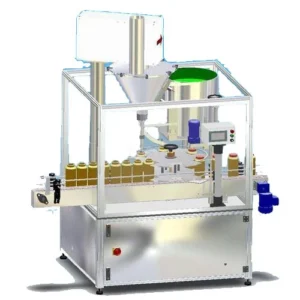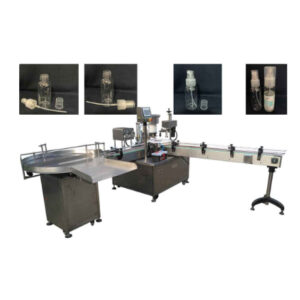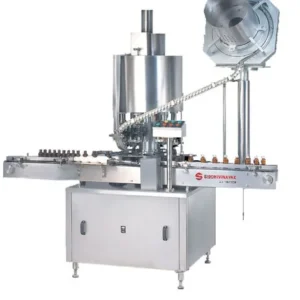Description
| Parameter | Specification |
|---|---|
| Machine Type | Automatic Capping Machine |
| Capacity | Up to 200 bottles/minute |
| Bottle Diameter Range | 20mm – 100mm |
| Cap Size Range | 10mm – 50mm |
| Power Supply | 220V/to110V/60Hz |
| Power Consumption | 3 kW |
| Air Pressure | 0.6 – 0.8 MPa |
| Air Consumption | 0.8 m³/min |
| Machine Dimensions | 2000mm x 1200mm x 1800mm |
| Weight | 800 kg |
| Material | Stainless Steel |
| Control System | PLC + Touch Screen |
| Capping Accuracy | ± 0.5 mm |
| Bottle Height Range | 50mm – 300mm |
| Suitable Caps | Screw caps, Press caps, etc. |
| Optional Features | Cap sorter, Cap feeder, Automatic cap tightening adjustment |
| Safety Features | An emergency stop button, Safety guarding, Overload protection |
This is an important piece of machinery found in the optical, food and beverage, cosmetic, and chemical sectors. It is designed to close containers by fitting caps or lids onto them securely. These machines are manufactured with different styles to accommodate varied types of containers and also caps ranging from bottles and jars to tubes and vials that have various shapes and sizes.
The whole process requires precise collaboration among the machines’ parts including the cap feeder, chute, cap sorter, and tightening mechanism to guarantee consistent sealing at all times. Depending on the need for capping which can be screw capping,g, snap capping, press-on capping, or induction sealing; there are different kinds of technologies used in this regard.
To minimize downtime and product wastage dulaborachine design in addition to ensuring proper functioning manufacturers put much emphasis on efficiency and accuracy. Most modern ones have some enhanced features such as automatic cap feeding mechanisms, torque adjustment units as well as quality control systems that make everything perfect for them.
Understanding Capping Machine
What Are Capping Machines?
These are special devices designed solely for fixing caps onto containers that ensure to-fitting seals. They come in different forms suited for various container shapes, sizes, and cap types from bottles/jars to tubes/vials.
Benefits of Capping Machines
Enhanced Efficiency: The use of these simplifies the packaging process while reducing manual labour and increasing throughput.
Improved Seal Quality: They produce uniform seals hence minimizing leakages or contaminations.
Versatility: The capability of handling diverse types of containers and caps makes cappers versatile in packaging processes.
Types Of Capping Machine
1. Screw Capping Machines
Screw capping machines are widely used when dealing with threaded caps on bottles/containers. They utilize a rotary motion for tightly securing these caps to bottles/containers ensuring accurate torquing across ranges of container sizes/materials. For instance, they can be used in the pharmaceutical, food and beverage, and cosmetic industries since they are very versatile.
2. Snap Capping Machines
Snap capping machines are designed for containers carrying snap-on caps. They allow the cap to be snapped into place quickly and efficiently without any need for a screw thread so that it is sealed effectively. This type of machine is popular among manufacturers aiming at high production rates as well as user-friendliness when producing products like beverages.
3. Press-On Capping Machines
Press-on capping machines apply pressure to press caps onto containers, creating a secure seal without threads. Ideal for press-fit or friction-fit caps on squeeze bottlthe es and tubes. In other words press-on capping machines are the simplest and most reliable of all types of such equipment about applications in the cosmetic and pharmaceutical industry.
4. Induction Sealing Machines
Induction sealing machines employ electromagnetic induction to provide an airtight seal between the cap and the container. Foil liners are commonly sealed by induction sealing machines which also offer security against tampering as well as leakage prevention. These devices are frequently used within food and drug-related areas where freshness must be maintained or safety guaranteed.
Applications Of Capping Machine
Pharmaceutical Industry
Cap feeding is among other functional features of the capping machine. Also, cap feeding involves supplying lids or caps to the machine for application on containers. The cap feeding systems may differ depending on the model used as well as the speed of the packaging line. Some examples of common cap feeding mechanisms are; rotary feeders, vibratory bowl feeders, and conveyor belt systems.
Cap Feeder
Cap handling is one of the aforesaid roles played by the capper machine because it feeds caps to the machine’s mechanism so that they can be put onto bottles. Cap feeders might vary depending on the kind of caps being used and the speed at which the packaging production line is running. These include rotary feeders, vibratory bowl feeders, and conveyors.
Cap Unscrambling
Once caps have been deposited in the capping machine, cap sorting, and orientation are next. It ensures that the caps are correctly placed and aligned for application on containers. Modern capping machines rely on detection sensors, vision systems, or mechanical components to identify and orientate the caps before a sealing operation is performed.
Container Handling
Conveyance tools which may include conveyors, grippers or clamps are fitted inside the capping machine while sealing. It is through such systems that container positioning accuracy as well as alignment required for proper sealing is achieved.
Cap Placement
The main function of a capping machine is to put caps on containers. Depending on the type of caps and containers being used, different methods of puttingbottlean be employethe d by capping machines such as screwing, popping onto place, pushing down, or induction sealing. To guarantee secure closure with every placement made precision engineering and control systems ensure accurate and consistent cap placement.
Torque Adjustment
Torque adjustment is another important feature in cappers. Torque refers to the rotational force applied to tighten caps onto containers. Cappers therefore allow an opertor to set these at various levels depending on cap types/containers/sealing requirements etc whereby exact torque adjustment helps avoid breaking glass or bending lids.
Tightening Mechanism
Capping machines provide tightening mechanisms for holding lids tightly against bottle tops during the closing process. Consequently, tightening mechanisms comprise either gripper assemblies chucks, or pneumatic actuators based upon respective closures. Thus tightening mechanisms ensure uniformity when it comes to closing done across all bottles in the production line.
Quality Control Systems
Modern Capping machines typically come with quality control systems that help maintain seal integrity during packaging operations. These may include sensors, vision systems, or pressure sensors for detecting any faults happening during the pasteurization stage. Quality control systems greatly reduce downtimes thus preventing waste from occurring.
Speed and Efficiency
Efficiency is essential for high-speed packaging lines, which is why capping machines are designed to fit into them. They’re built to run at high speed while maintaining accuracy and dependability. By using servo-driven mechanisms and programmable logic controllers (PLCs) advanced automation features enhance productivity to minimize downtime.
Versatility and Flexibility
Capping machines can handle a wide range of container shapes, sizes, and cap types. Hence, they are highly versatile and flexible in adapting to changing production requirements or packaging formats. Quick-changeover abilities as well as adjustable settings allow the machine to handle different products or packaging configurations.
Safety Features
Safety forms an integral part of capping machine design. These machines have features such as interlocks, guards, or emergency stop buttons for operators’ safety during operations. This safety standards compliance ensures a safe working environment in manufacturing facilities.
Frequently Asked Questions
1. What is a capping machine?
It is a device that covers containers with caps or lids so that they can be sealed safely. The equipment enables the right placement of caps on containers; thus making it possible for them to be tightly sealed.
2. What types of caps can a capping machine handle?
Some cap varieties that can be managed by this machine include screw caps; press-on caps; snap-on caps; induction-sealed caps etc.
3. What industries typically use capping machines?
Those sectors using these devices are pharmaceuticals, food & beverage, cosmetics health care products, chemicals paint industry (coatings), automotive cars production line (assembly plant), household goods etc.
4. How do I choose the right capping machine for my packaging needs?
The primary factors one should consider when choosing a sealing device include container type, lid style, production rate as well as sealing method of your item.
5. Can capping machines accommodate different container sizes and shapes?
Different models of these tools are capable of sizing up diverse packages including those made of glass or plastic materials.
6. Are capping machines easy to operate and maintain?
Regarding operation aspects, modern models come along with friendlier user interfaces whereas regular cleaning activities and lubrication ensure high performance at all times.
7. What safety features should I look for in a capping machine?
Some of the safety devices or precautions that one ought to look for when purchasing a capper include interlocks, guards, emergency stop buttons, and safety sensors.
8. Can capping machines be integrated into existing packaging lines?
Such machinery can also be fixed in an ongoing production operation with slight adjustments on the line thus ensuring smooth operations.
9. How do capping machines contribute to product quality and integrity?
These sealing systems are important in maintaining the freshness of a product without leaking because they provide consistent and reliable sealing preventing contamination or tampering during handling.
10. What support and services are available for capping machine maintenance and repair?
To keep your cap seals in good shape many companies offer their clients assistance like installing, training, maintaining, and repairing these equipment while minimizing downtime.





